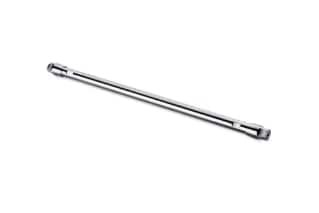Gene-Based Therapeutics (GTx) Columns
Confirm physicochemical properties and resolve impurities
Gene therapies have advanced over the past decade to become a promising class of therapeutics capable of treating many different intractable diseases. On the path to creating and releasing these medicines, there can be uncertainty around drug design, physicochemical properties, impurities, and their correlation to potency and safety.
Chromatography columns with improved recoveries, higher resolution, and greater efficiency make it possible to resolve some of this uncertainty. Waters Gene Therapeutics (GTx) Columns offer the range of columns you need for the many different modalities your lab needs to analyze – a range that includes reversed-phase liquid chromatography (RPLC), anion exchange (AEX), hydrophilic interaction chromatography (HILIC), and size-exclusion chromatography (SEC). Having the right column on hand can make all the difference.
Specifications
Overview
- Take robust physicochemical characterization and quantitative measurements with chromatographic methods
- Choose the ideal retentivity and selectivity with Waters' range of RPLC, AEX, HILIC, and SEC columns
- Select an appropriate oligonucleotide or nucleic acid standard to facilitate system suitability and proficiency testing
Recommended Use: For answering questions about the potency and safety of your gene therapeutics using the accurate, high-throughput data.
Features Header
Size exclusion chromatography for potency and purity indicating assays
Advances in SEC make it possible to quickly perform potency indicating assays that check aggregation, measure vector fill percentages, and facilitate in-depth characterization of impurities. SEC can also be applied to mRNA, polyA tails, CRISPR RNPs, and sgRNA analyses.
GTxResolve Premier BEH SEC 450Å 2.5 µm Columns offer a low adsorption, high-efficiency SEC column technology to facilitate these assays and the use of advanced detectors for multi-attribute measurements. These columns are well suited to the analysis of AAV gene therapies.
The success of mRNA-based medicine has depended upon the use of efficient delivery vehicles, such as lipid nanoparticles (LNPs) that serve as protective carriers. In addition to their use for medium to large mRNA, GTxResolve Premier SEC 1000Å 3 µm Columns allow analysts to gain valuable insights on some types of LNPs, such as Comirnaty™ vaccines. Moreover, GTxResolve Premier SEC 1000Å 3 µm Columns can help viral vector developers elucidate the degradation pathways that lead to highly aggregated samples. The uses of widepore SEC columns are many!
Explore Widepore SEC Columns
Ion-pairing reversed phase for integrity and purity analysis
Advanced analytical methods involving ion-pairing reversed-phase liquid chromatography can help ensure the identity, purity, integrity, and intended modifications of oligonucleotide and nucleic acid therapeutics.
ACQUITY and XBridge Premier Oligonucleotide BEH C18 Columns are constructed with high-performance surfaces and oligonucleotide batch tested sorbent to ensure reliable separations and a painless turnaround of critical results.
Meanwhile, ACQUITY Premier Oligonucleotide BEH C18 2.1 x 20 mm Columns provide new options for achieving ultrafast chromatography. These columns have been carefully optimized for both efficiency and mechanical durability, offering improved throughput for purity, identity, and critical quality attribute testing.
Explore Oligonucleotide RPLC Columns
HILIC Chromatography for Gene Therapeutics
HILIC can retain synthetic oligonucleotides, single guide RNA (sgRNA), messenger RNA (mRNA digests), and viral capsid proteins without needing ion pairing reagents in the mobile phase. Assay your purity, size variants, failure sequences, nucleotide modifications, and backbone variants in a MS-friendly buffer. GTxResolve Premier Amide columns are double batch tested with protein and oligonucleotide controls to ensure optimal chromatographic performance for cell and gene therapy separations.
Explore GTxResolve Premier HILIC Columns
Anion exchange for viral vectors, oligonucleotides, and nucleic acids
Anion exchange is a powerful technique for viral vectors, oligonucleotides, and nucleic acids as they are all anionic.
Explore Analytical AEX Columns
Protein-Pak Hi Res Q and Gen-Pak FAX Columns provide two unique chemistries for performing assays that can check vector fill, measure titer, and check topology/integrity. Protein-Pak Hi Res Q contains a 5 µm quaternary amine (SAX) resin and the Gen-Pak FAX Column contains a lower retentivity WAX 2.5 µm DEAE sorbent.
Explore Semi-Prep AEX Columns
Oligonucleotide and Nucleic Acid Standards
A selection of different chromatography standards are available, including individual oligonucleotides, sets of different single standard DNA (ssDNA) ladders, a lipid conjugated antisense oligonucleotide, and larger double stranded DNA ladder.
Explore Standards
Preparative scale RPLC for chemically synthesized oligonucleotides
Preparative HPLC is regularly performed to purify chemically synthesized oligonucleotides.
Waters Optimal Bed Density (OBD) 10 to 50 mm ID Columns packed with oligonucleotide tested ethylene bridged hybrid (BEH) C18 particles offer high-efficiency, long-lived setups for such a critical process.
Stay compliant with smart column options
Ideal for compliant laboratories, smart column options are available for identifying and tracking column information. The eCord is a data recording device which is permanently attached to the column body of 2.x µm particle size (2.1 and 3.0 mm internal diameter) and ACQUITY UPLC columns and is standard for those column offerings. Rather, the eConnect column tag is a permanently attached electronic tag device for HPLC columns (≥ 2.x µm particles) used with Alliance iS and Alliance iS Bio HPLC Systems that are optional. Data from column devices (eCord device or eConnect column tag) can be accessed using the respective system’s console. These smart-column abilities provide a quick overview of column history and can be utilized as a basic troubleshooting tool. Data residing on these devices are automatically imported by and later searchable via Empower CDS.
